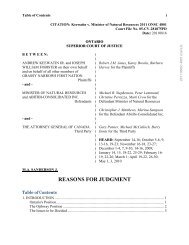Strategies for Executive Compensation: Design and Tax Issues for a ...
Strategies for Executive Compensation: Design and Tax Issues for a ...
Strategies for Executive Compensation: Design and Tax Issues for a ...
You also want an ePaper? Increase the reach of your titles
YUMPU automatically turns print PDFs into web optimized ePapers that Google loves.
- 20 -<br />
become payable due to a clawback, the employee would repay the loan. While<br />
imperfect <strong>and</strong> slightly cumbersome, this method would avoid having to unwind an<br />
income inclusion in a prior year.<br />
Care will need to be taken to structure the loan such that it is clearly a loan <strong>and</strong> not, <strong>for</strong><br />
example, a taxable advance, or in the case of an employee who holds shares, a<br />
shareholder benefit.<br />
(c)<br />
Use of a Trust<br />
The bonus could be structured using a trust to hold employer stock during the clawback<br />
period. Upon issuance of the stock to the trust, the employee would have an income<br />
inclusion (see Subsection 7(2) <strong>and</strong> paragraph 7(1)(a) of the Act). (It is assumed the<br />
deferral provided <strong>for</strong> in subsection 7(1.1) <strong>for</strong> shares of a Canadian-controlled private<br />
corporation would not be relevant in the context of clawbacks.) At the end of the<br />
clawback period, if the stock is released from the trust, the employee would not have an<br />
additional income inclusion <strong>and</strong> would be able to liquidate the stock. If the clawback<br />
was engaged prior to the release of the stock to the employee, <strong>and</strong> the arrangement<br />
provided <strong>for</strong> the stock to be returned to the issuing employer, the employee would be<br />
entitled to a deduction in computing income equal to the amount of the income inclusion<br />
in the prior year under Subsection 8(12) of the Act. Subsection 8(12) of the Act<br />
provides a deduction <strong>for</strong> an employee who <strong>for</strong>feits rights to a share in certain<br />
circumstances. The deduction is available if the employee is deemed to have disposed<br />
of the share held by a trust pursuant to subsection 7(2) of the Act. The trust must have<br />
disposed of the share to the corporation that issued the share as a result of the<br />
employee failing to meet the conditions necessary <strong>for</strong> title to the share to vest in the<br />
employee. Furthermore, the corporation must acquire the share from the trust or<br />
redeem or cancel it <strong>for</strong> an amount no greater than the price paid to acquire the share<br />
from the corporation.<br />
If the <strong>for</strong>egoing conditions are satisfied, the employee may, in the year of <strong>for</strong>feiture,<br />
deduct the excess of the amount of the benefit deemed to have been received by the
















